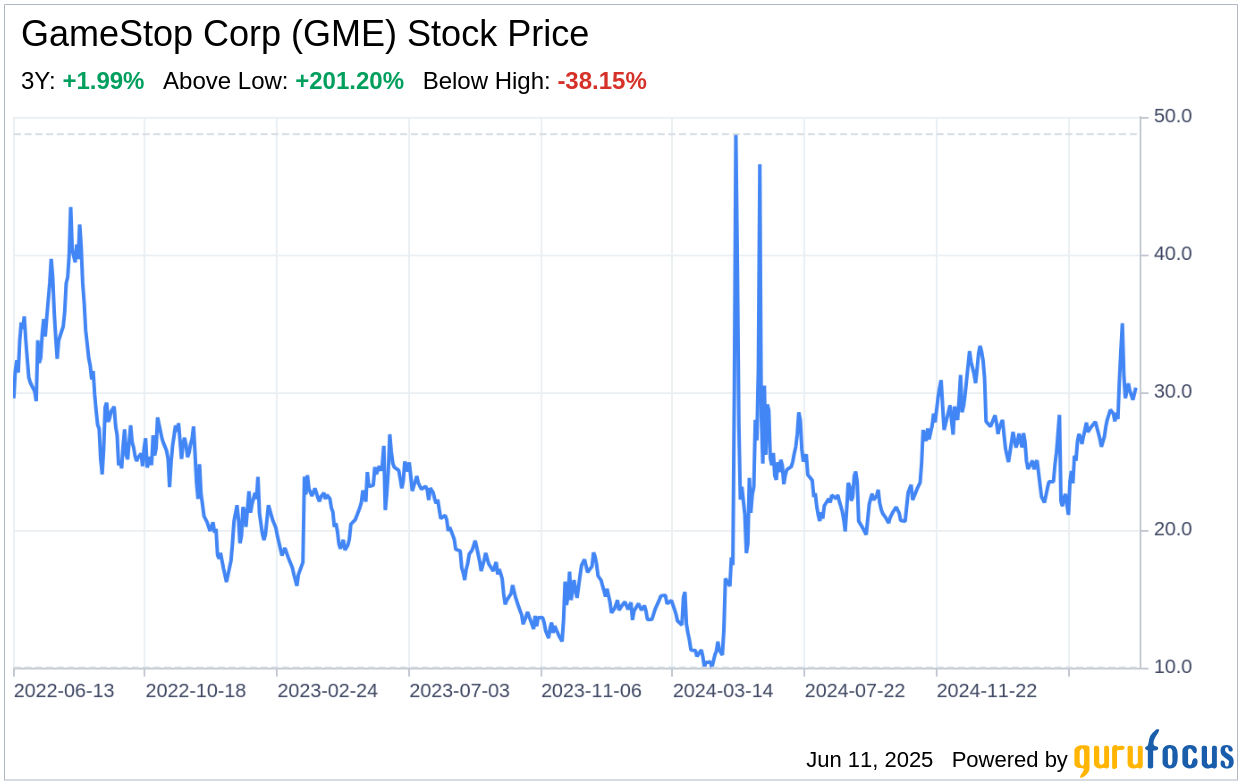GameStop Corp (GME, Financial), the renowned video game and consumer electronics retailer, has released its 10-Q filing dated June 10, 2025, offering a glimpse into its financial performance and strategic direction. The company, which operates across multiple geographies, has shown a remarkable turnaround with a net income of $44.8 million for the three months ended May 3, 2025, compared to a net loss of $32.3 million in the same period last year. Despite a decrease in net sales from $881.8 million to $732.4 million, GameStop has managed to reduce its operating loss and improve its gross profit margin. These financial tables set the stage for a detailed SWOT analysis, providing insights into GameStop's internal dynamics and its adaptability in a rapidly evolving retail landscape.

Strengths
Brand Recognition and Loyalty: GameStop's brand is synonymous with gaming culture, boasting a loyal customer base that has been cultivated over years. The company's reputation as a go-to destination for video game enthusiasts provides a competitive edge in the retail sector. This loyalty is further reinforced by the GameStop Pro® rewards program, which incentivizes repeat business and fosters a sense of community among gamers.
Financial Resilience: The recent financial turnaround, as evidenced by the swing to net income in the latest quarter, highlights GameStop's financial resilience. The company's ability to reduce selling, general, and administrative expenses from $295.1 million to $228.1 million, alongside a gross profit increase from $244.5 million to $252.8 million, demonstrates effective cost management and an improved balance sheet.
Omnichannel Retail Strategy: GameStop's focus on establishing omnichannel retail excellence has allowed it to integrate its physical stores with e-commerce platforms effectively. This strategy enables the company to meet customer demands across various touchpoints, providing convenience and enhancing the shopping experience.
Weaknesses
Declining Net Sales: The 16.9% decrease in net sales is a significant concern for GameStop. This decline reflects the challenges faced in the retail sector, particularly in the European and Canadian markets, where sales have dropped considerably. The company must address the underlying causes of this decline to stabilize and grow its revenue streams.
Asset Impairments: The recent filing indicates asset impairments of $35.5 million, signaling the need for GameStop to reassess the value of its assets, particularly in light of its divestitures in Canada and France. These impairments suggest that certain assets may no longer be generating the expected returns, necessitating strategic realignment.
Market Saturation and Competition: GameStop operates in a highly competitive market with increasing digital distribution of video games. The company's reliance on hardware and accessory sales, which constitute the majority of its revenue, is threatened by the shift towards digital and the presence of formidable competitors such as Amazon and Walmart.
Opportunities
Expansion into Graded Collectibles: GameStop's collaboration with Collectors Holdings, Inc. and its entry into the graded collectibles market present new revenue opportunities. This diversification allows GameStop to tap into the growing market for collectibles, leveraging its existing customer base and retail expertise.
Digital Asset Investments: The company's revised investment policy, which includes the addition of Bitcoin as a treasury reserve asset, positions GameStop at the forefront of digital asset investment among retailers. This forward-thinking approach could yield significant returns and attract a new demographic of tech-savvy consumers.
International Market Optimization: GameStop's strategic divestitures and focus on profitable markets offer the opportunity to streamline operations and concentrate resources on areas with the highest growth potential. The company's exit from underperforming markets can lead to improved efficiency and profitability.
Threats
Industry Shift to Digital Distribution: The video game industry's shift towards digital distribution poses a threat to GameStop's traditional business model. As more consumers opt for digital downloads, the company's physical software sales are likely to decline, necessitating a strategic response to this industry trend.
Economic Uncertainty: Macroeconomic factors, such as inflation and currency fluctuations, can impact GameStop's international operations and profitability. The company must navigate these uncertainties carefully to maintain its financial health and competitive position.
Legal and Regulatory Challenges: GameStop faces various legal proceedings and regulatory requirements that could result in financial liabilities or reputational damage. Staying compliant and managing these risks is crucial for the company's long-term success.
In conclusion, GameStop Corp (GME, Financial) has demonstrated its ability to navigate a challenging retail environment with a strategic focus on cost optimization, digital asset investments, and expansion into new product categories. However, the company must continue to adapt to the industry's digital transformation and address declining net sales to maintain its competitive edge. With a strong brand and a loyal customer base, GameStop is well-positioned to leverage its strengths and capitalize on emerging opportunities while mitigating its weaknesses and external threats.
This article, generated by GuruFocus, is designed to provide general insights and is not tailored financial advice. Our commentary is rooted in historical data and analyst projections, utilizing an impartial methodology, and is not intended to serve as specific investment guidance. It does not formulate a recommendation to purchase or divest any stock and does not consider individual investment objectives or financial circumstances. Our objective is to deliver long-term, fundamental data-driven analysis. Be aware that our analysis might not incorporate the most recent, price-sensitive company announcements or qualitative information. GuruFocus holds no position in the stocks mentioned herein.
